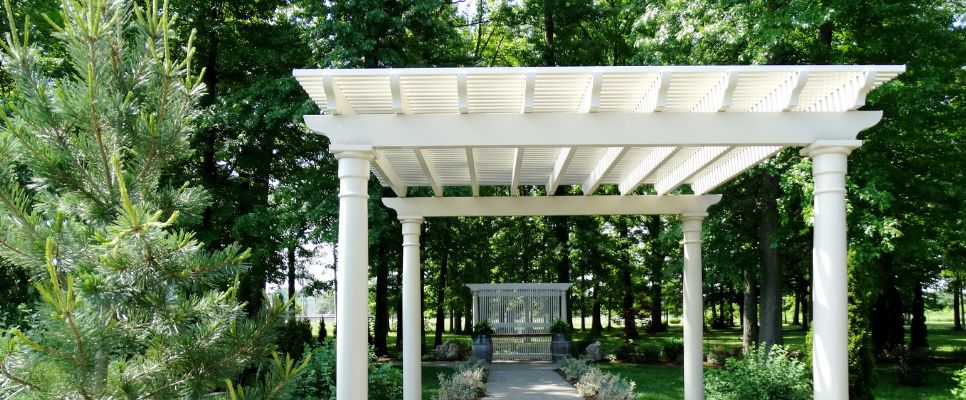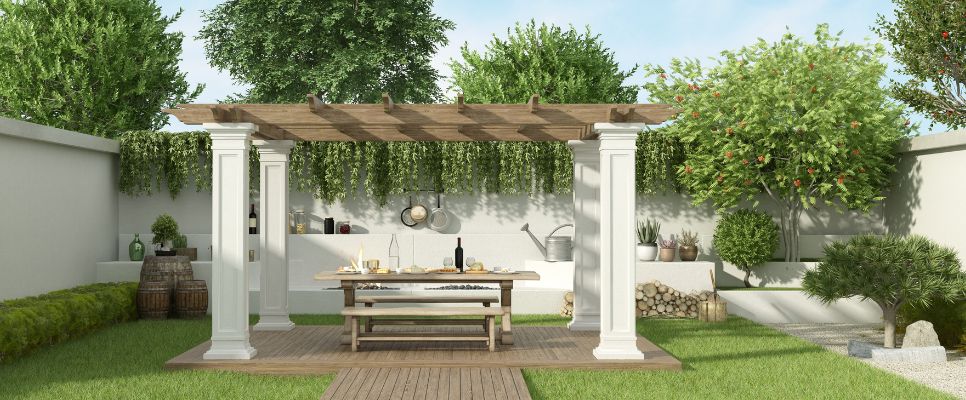How Much Does A Gazebo Cost? Types And Their Costs in Australia
Are you installing a gazebo in your home backyard space? Gazebos stand as one of the most adaptable outdoor features that enhance every Australian residential property because they provide shady areas for relaxation during the morning or weekend activities, or spa protection. Understanding all costs related to gazebo construction becomes imperative before advancing into design decisions.
Australian gazebo prices exist on a broad spectrum, starting at $500 for temporary pop-up models and extending to $20,000 for personalized timber designs that include comprehensive features. Your final cost for a gazebo depends on six main elements, such as gazebo design type and size, along with material selection and installation approach, and additional choices of roofing, flooring, and lighting.
This gazebo installation cost guide provides complete information about gazebo pricing trends, with simple kits available at affordable prices up to the most expensive custom-built gazebos.
What Is a Gazebo?
Understanding the core concept of a gazebo needs to happen before exploring pricing information. The freestanding open-air structure known as a gazebo appears primarily in gardens as well as patios and parks across the landscape. Manufacturers build most gazebos with a rain and sun-proof roof made from timber, wood, steel, aluminum, or other materials. A temporary portable gazebo comes in the form of pop-up models, but permanent structures integrate themselves into the landscape design.
A gazebo can appear in various forms, including circular shapes and rectangular shapes, or hexagonal and octagonal geometries, and acts as an outdoor point of focus. Different types of gazebos exist, ranging from basic sun shields to luxury entertaining pavilions that meet the needs of many Australian residences consult with local gazebo builders.

Average Cost of a Gazebo in Australia
Each cost level offers certain features. The prices for Australian gazebos follow this scale of estimates:
- Portable pop-up gazebos: $100 – $500
- Basic DIY gazebo kits: $1,000 – $5,000
- Prefabricated gazebos (flat-pack): $3,000 – $10,000
- Custom-built timber or steel gazebos: $7,000 – $25,000+
Types of Gazebos and Their Costs
Pop-Up Gazebos: Budget-Friendly Shade
Users install pop-up gazebos because these portable folding structures serve events, along with markets, and create temporary shade structures. Such structures lack weather resistance, but they work well for casual usage.
- Cost: $100 – $500
- Materials: Steel/aluminium frame with polyester canopy
- Size: Usually 2m x 2m to 3m x 6m
- Installation: DIY setup in minutes
DIY Gazebo Kits: Affordable and Attractive
DIY kits provide higher durability alongside enhanced appearance quality. The packages arrive at you fully prepared for assembly by yourself (or with the help of a professional tradesperson).
- Cost: $1,000 – $5,000
- Materials: Treated pine, merbau, aluminium, or steel
- Size: 3m x 3m to 4m x 5m
- The cost for manual installation by a handyman ranges from $70 to $100 per hour.
DIY gazebo kits typically deliver roofing components but do not contain essential elements such as flooring and lighting, or painting amenities.
Prefabricated Gazebos: Mid-Range Permanent Structures
You can obtain prefabricated gazebos, which come either as flat-packed items or partially constructed materials for home delivery. Some retailers supply their packages with installation services.
- Cost: $3,000 – $10,000
- Materials: Powder-coated steel, hardwood, or composite
- Size: 4m x 4m to 6m x 6m
- Installation: Professional assembly is usually recommended
The majority of these gazebos feature roof coverage, together with securing mechanisms and weather-proof elements.
Custom-Built Gazebos
Custom-made backyard designs allow you to customize a gazebo exactly to your preferences, including matching your property style, along with power outlets and plumbing options, and seating features.
- Cost: $7,000 – $25,000+
- Installation of custom-built gazebos requires hardwood timber and Colorbond steel components, along with composite decking and options between tile or shingle roofing.
- Round Gazebos come in completely adaptable dimensions that range between 4m x 4m up to 8m x 6m.
- Installation: Licensed builder, carpenter, or landscaper
The building process of custom designs calls for separate costs to cover the requirements of council projects, together with base work and garden arrangements.
Steel and Aluminium Gazebos: Durable and Low Maintenance
Gazebos built from steel and aluminium materials provide durable performance, together with minimal requirements for upkeep. Homeowners pick these structures when they want a modern yet weather-resistant outdoor element that comes with low maintenance requirements beyond timber.
- Cost: $2,000 – $10,000
- Steel producers use powder coating on their aluminium materials while also working with galvanised or stainless steel elements.
- Steel and aluminium gazebos can be ordered from 3m by 3m to 4m by 6m, with bigger customized sizes available upon request.
- Professional tradespeople charge between $70 and $120 as their hourly rate for installing these structures.
The base roof framework and walls exist within the standard price, but additional elements, including flooring or integrated screens with automated louvres, require additional payment.
Bali Huts and Thatch-Roof Gazebos: Tropical Style for Outdoor Living
Bali huts, together with thatch-roof gazebos, provide tropical resort aesthetics that work well for swimming areas alongside gardens. The unique style of these structures naturally creates an atmosphere of relaxed exoticism that works well for entertaining family members and relaxing.
- Cost: $3,000 – $12,000
- The essential components for construction consist of natural thatch (considering Cape reed from Africa or Balinese grass) together with treated hardwood timber materials.
- Size: 3m x 3m to 5m x 5m
Bali huts include authentic thatched roof coverings which rest on long-lasting timber frames. The cost of professional carpenter installation for such structures typically falls between $80 to $120 per hour.
Key Factors Affecting Gazebo Costs
The prices of different gazebos vary distinctly from one another. Multiple key elements determine how much a customer will pay for a gazebo.

Size and Shape
Gazebos, which are bigger, require higher costs because they both need additional materials as well as elaborate installation methods.
- Small (2m x 2m): $500 – $3,000
- Medium (3m x 3m to 4m x 4m): $4,000 – $10,000
- Large (5m x 5m and bigger): $10,000 – $25,000+
Materials
Your decision about gazebo material determines the financial investment at first purchase and the frequency of needed maintenance work.
Timber:
- High cost.
- Offers a warm, natural aesthetic.
- You must perform regular duties on this material by applying staining solutions and sealants.
Aluminium:
- Mid-range cost.
- Lightweight and naturally rust-resistant.
- Ideal for modern, low-maintenance designs.
Steel:
- Mid-to-high cost.
- Extremely durable and strong.
- Holiday makers must reinforce their foundations when utilizing heavy gazebo structures due to their construction weight.
Vinyl/PVC:
- Low-to-mid cost.
- The material requires minimum care because it stands up well against weather elements.
- Best for simple, budget-friendly installations.
Roofing Options
A roof material selection relates directly to appearance, alongside financial considerations.
- Colorbond® Steel: $20–$60/m²
- Polycarbonate Roofing: $25–$70/m²
- Thatched Roof (Bali Style): $150–$300/m²
- Tiled Roof (Terracotta, Slate): $80–$150/m²
The cost of premium roofing materials, including copper or tile, creates an eye-catching appearance for gazebos, although the price tag will be expensive.
Foundation or Decking
The expenses required to add either a deck or slab, or reinforced footings must be included in your financial plan for the gazebo project.
- Concrete slab: $70–$120 per m²
- Timber decking: $200–$450 per m²
- Paving stones: $50–$100 per m²
Installation and Labour
Gazebo installation expenses between $1,000 to $5,000, depending on the complexity of the design work.
- Labour costs vary by state:
- NSW and VIC: $70–$120/hour
- QLD and WA: $65–$100/hour
- SA and TAS: $60–$90/hour
Professional experts such as builders and carpenters must be hired for constructing permanent or complex gazebos.
Hidden Costs to Watch Out For
Projects built with gazebo structures tend to develop hidden construction expenses. Budget ahead for:
- Site preparation (clearing, levelling ground): $500–$2,000
- Electrical works (outdoor lighting, fans): $500–$2,500
- The cost for proper drainage installation ranges from $800 to $3,000 when water pooling exists.
- Council fees and drawings: $300–$1,200
- You should prepare approximately $300–$500 each year for ongoing maintenance of timber gazebos through sealing tasks and oil applications, and repairs.
How to Save Money on Your Gazebo Project
Here are some savvy tips:
- Kits for gazebos tend to be less expensive than custom-made models.
- Homeowners with building experience can perform their installation to decrease job-related expenses.
- Select either rectangular or square shapes for a gazebo instead of building an octagonal design.
- Upgrading to resistant building materials at the outset brings financial stability because it reduces the cost of maintenance over time.
- Dealing with three professional installers when seeking multiple quotes is essential.
Conclusion
Outdoor spaces gain tremendous value through the addition of a gazebo, which serves as a comfortable retreat that works well for relaxation and entertaining throughout Australia's year-round climate. A gazebo suits all design needs and budgets, regardless of yard space, so you can find an option that matches your preferences. Your new gazebo design will deliver lasting home value when you select materials carefully while ensuring proper installation and controlling any council requirements.







